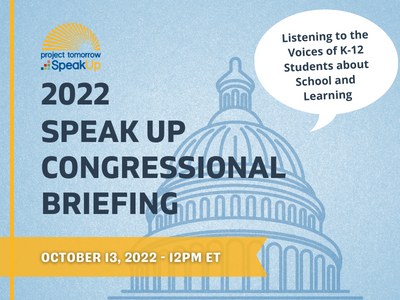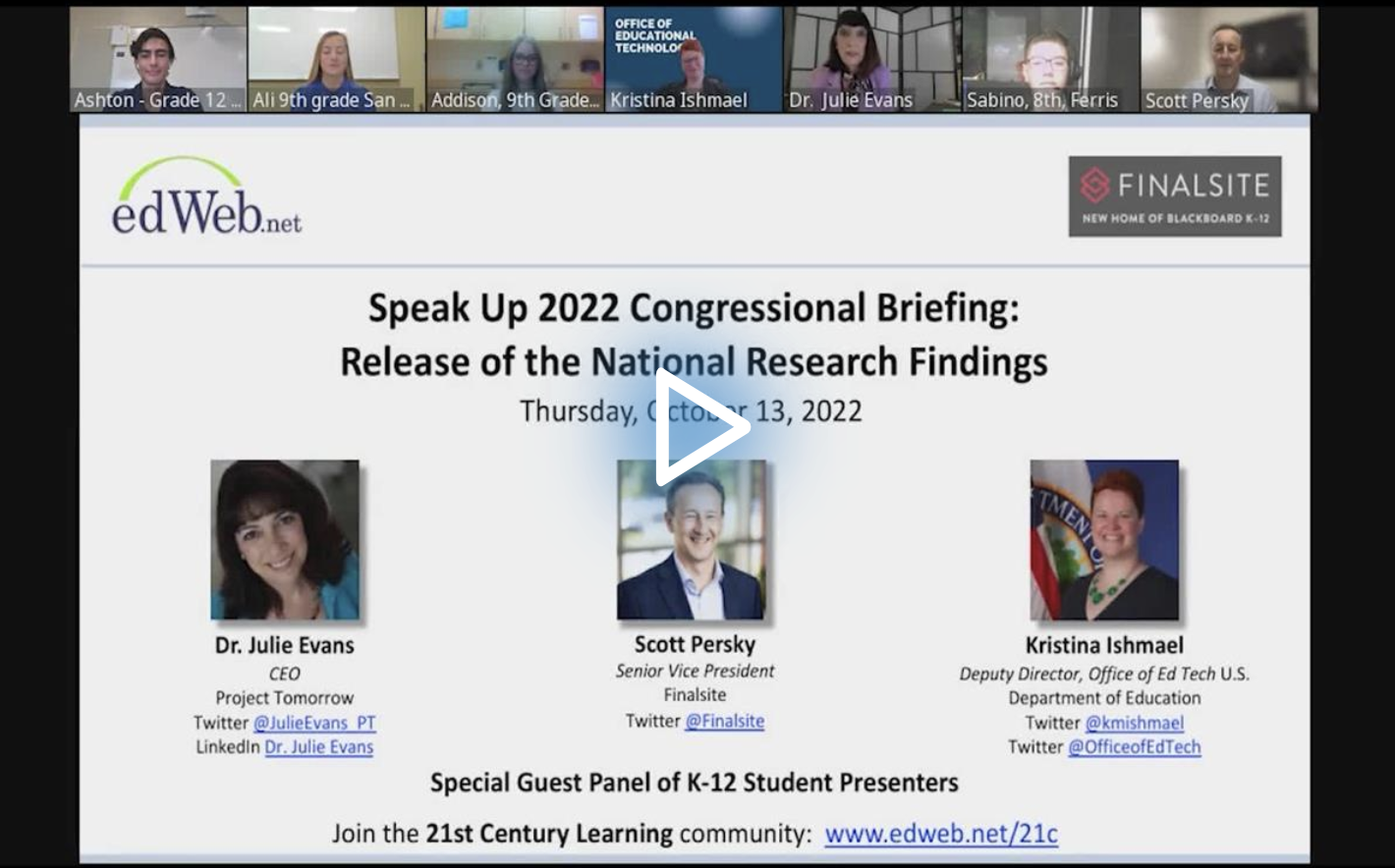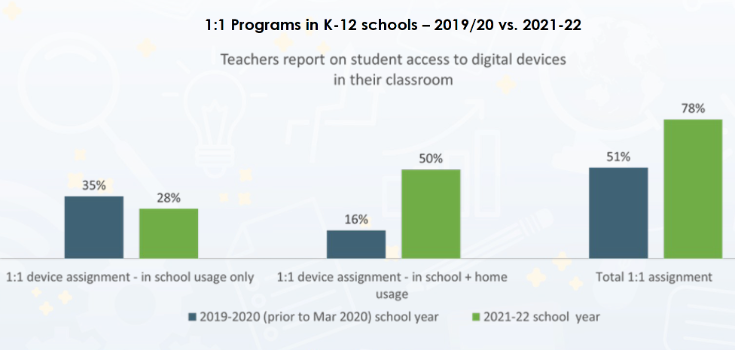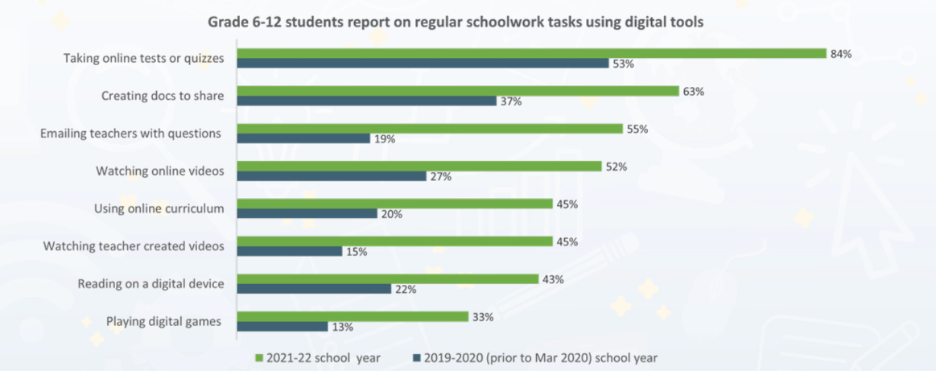Technology’s Impact on Student Learning: Insights from the Speak Up 2022 Congressional Briefing
Watch the Recording Listen to the Podcast
In 2003, Project Tomorrow, a national nonprofit dedicated to helping K-12 education leaders identify and implement best practices, launched the Speak Up Research Project, which gives K-12 leaders insights into current and emerging dynamics in the education ecosystem—and what those dynamics mean for all the stakeholders within a school district.
The most comprehensive data set on digital learning, Speak Up provides feedback from more than 6.2 million K-12 stakeholders, which helps inform decisions at the local, state, and federal levels. Project Tomorrow aggregates and analyzes data from survey results of stakeholders (students, teachers, parents, school administrators, etc.) and produces a series of reports, infographics, and an annual Congressional Briefing.
During the “Speak Up 2022 Congressional Briefing: Release of the National Research Findings,” Dr. Julie Evans, CEO of Project Tomorrow, presented the findings of the 2021-2022 Speak Up survey and moderated a discussion with student experts who shared their experiences and insights about new models of learning, preferred uses of technology, and ideas on how to improve student engagement. Dr. Evans was joined by Scott Persky, Senior Vice President of Finalsite, and Kristina Ishmael, Deputy Director of the U.S. Department of Education’s Office of Education Technology.
National Education Technology Plan
Created by a Congressional mandate in the 1990s, the Office of Education Technology is tasked with developing a national education technology policy, which they do through the publication of a National Education Technology Plan. The research data from the Speak Up Research Project as well as information gathered from other organizations, like SETDA, InnovateEDU, and Learning Forward provide guidance and key insights to create the plan.
Ishmael shared that they are in the process of drafting a new plan, which has three top priorities: digital inclusion, ecosystems, and emerging trends and technologies. The plan also spans the breadth of education, encompassing early learning, K-12, higher education, and the workforce.
Speak Up 2021-2022 Data Sets
Facilitated through schools and school districts, more than 75,000 K-12 students, parents, teachers, and administrators submitted a Speak Up survey. The participation was diverse and included schools that were:
- 41% urban
- 31% rural
- 28% suburban
- 68% Title 1 eligible
The findings from these surveys were revealing. Most notable is that the disruptions in K-12 education caused by the pandemic have permanently changed the way schools function, and this shift is not isolated to education. For example, recent surveys show an increasing number of people prefer remote work options, telehealth services, and food delivery services. A recent Pew Research study shows that 40% of Americans say their dependence on new technologies and tools is a positive in terms of being better connected with their family, friends, and associates.
Little Red Schoolhouse Nostalgia
While it is clear the pandemic created seismic changes in education, there are those who still pine for the nostalgia of the little red schoolhouse. However, reality paints a much different picture as demonstrated by another interesting data point from the Speak Up survey: 89% of district administrators across the country said they agree that the pandemic and the necessary shifts and disruptions in K-12 education have changed schools forever. That is an overwhelming number of education leaders, so much so that Project Tomorrow concludes it is not possible, realistic, or advisable to return to pre-pandemic education practices.
Following the Data
Since the late 1990s, school districts across the country have had plans to make 1:1 devices (laptops, tablets, etc.) available to their students. While some districts got there faster than others, 1:1 remained a challenge before the pandemic. With students having to learn remotely, many districts had to make rapid changes, which have led to permanent changes in 1:1 accessibility and usage as demonstrated by the following data sets:
The most dramatic changes can be seen in the access to digital devices at home, which drastically changes learning opportunities, not only in the classroom in terms of more access, but also for extended learning, ongoing communications, and collaboration opportunities with other students and with teachers.
Also, the ways in which students are using their devices and associated digital tools (apps, platforms, etc.) have increased and expanded:
While taking online tests/quizzes remains the number-one use, communication with teachers has increased substantially as well as student collaboration on assignments.
The embrace and use of technology extends to teachers and parents as well. A few interesting data points include:
- In 2019-20, only 17% of teachers said they take advantage of students’ 1:1 device access in their lessons, compared to 50% in 2021-22
- In 2019-20, just 21% of teachers said they personalized learning for their students, compared to 38% in 2021-22
- In 2019-20, 22% of teachers said they allowed students to have a choice about how they want to learn, with 35% answering positively in 2021-22
- In 2018, 65% of parents surveyed said they favored the class/school portal to communicate with teachers. In 2021-22, parents, across all generation groups, favored text messaging with teachers
Desired Student Outcomes: Personalization and Career Exploration
During the Congressional Briefing presentation, four student experts were asked to share their experiences and insights, which were reflective of the findings in the report. The student experts were Ashton, a 12th-grade student from San Marcos High School in North San Diego, CA; Addison, a ninth-grade student from Lincoln High School in Talladega County, AL; Sabino, an eighth-grade student from Ferris, TX; and Ali, a ninth-grade student from Santana High School in San Diego, CA.
Each student shared how they used technology to interact with their teachers, other students, and for their own education purposes, such as research or artistic creativity. Ranging from regularly emailing with their teachers to watching online videos to creating projects using online tools, it became evident that, for this generation of students, technology is not a “nice-to-have feature” but a utility that enables them to pursue their academic studies efficiently and effectively.
On the Speak Up survey, a majority of students identified “personalization of the learning process” as their top desired outcome to using technology in school. When asked specifically about personalization, students responded:
- Learning at my own pace: 59%
- In control of my own learning: 53%
When the student experts were asked how they would design a school of their choice, they echoed the sentiment of personalized instruction with the explicit desire to help them identify a future career path. Personalization along with the relevancy of learning with the intent of putting that learning into practice was repeated in one way or another throughout the conversation.
In terms of student engagement, the student experts all agreed that when teachers “gamify” a lesson or group activity, engagement goes up and students are more excited and involved in the activity. They pointed to apps like Kahoot, Gimkit, and Quizlet as tools that are used by teachers to gamify instruction.
Capitalizing on the Moment
Bolstered by this new data, Project Tomorrow and their supporting organizations believe education can capitalize on this moment in time where teachers can become facilitators of learning with students embracing self-directed learning opportunities. These opportunities hold greater value for many students as they also influence their expectations for in-school experiences.
A newly published resource to help school leaders shift to self-directed learning models is Free Agent Learning: Leveraging Students’ Self-Directed Learning to Transform K-12 Education. Authored by Dr. Evans, the book uses data from Project Tomorrow to demonstrate how students are using their own technology with purposeful intent to self-remediate, research careers, and prepare themselves for the future—while also searching for ways to provide these kinds of experiences within their schools.
The entire 2022 Speak Up Report is now available at Project Tomorrow. Previous reports, efficacy studies, and other resources are also available, for free, in their publications section. The 2022-2023 Speak Up survey is also available, for free, through May 13, 2023, to any schools or districts interested in participating.
Learn more about this edWeb broadcast, “Speak Up 2022 Congressional Briefing: Release of the National Research Findings,” sponsored by Finalsite (new home of Blackboard K-12).
Watch the Recording Listen to the Podcast
Join the Community
21st Century Learning is a free professional learning community that serves as a forum for collaboration in a world where change is constant and learning never stops.
Finalsite is the preferred website and digital communications provider of more than 5,000 school districts across the country. We make it easy for schools and districts to transform community engagement, recruit staff and strengthen your online presence; while managing the complex requirements around data privacy, accessibility, hosting, and security.
With scalable solutions to meet every district’s unique needs, 24-7 support, in-house accessibility specialists and tactical website deployments, Finalsite (new home of Blackboard K-12) is equipped to help districts of all sizes launch and maintain websites that improve communications outcomes. For more information, please visit www.finalsite.com.
Blog post by Ginny Kirkland, based on this edLeader Panel








Comments are closed.